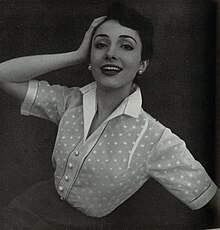
Lola Prusac (18 January 1895 – 29 October 1985) was a Polish-born French fashion designer noted for her inventive and original way of dressing, [1] who worked for Hermès in Paris between 1925 and 1935. [2] She was first "with the unusual position of counselor for colors", [3] then as a modéliste ( designer). [4] At Hermès she designed in 1929 their first women collection, [5] silk squares,. [6] and in the early 1930s bags with geometric inlays inspired by the Dutch painter Mondrian. [7] In 1936, she founded her own fashion house, [8] specialising in "sport-tricot" (casual knits) clothes. [9] For this reason, though she had been a member since 1942, the Chambre Syndicale de la Haute Couture denied her in 1952 the "Couture-Création" status. [9] [10]
In 1978, Lola Prusac received an aiguille d'or (golden needle), a French award sometimes granted together with the more prestigious dé d'or (golden thimble). [11][ full citation needed].
- ^ "Lola Prusac un chic excentrique". Jardin des Modes (in French): 18. September 1993.
-
^ Jean-R., Guerrand (1987). Souvenirs cousus sellier: Un demi-siècle chez Hermès (in French). Paris: Editions Olivier Orban. p. 58.
ISBN
978-2-85565-377-8.
Polonaise d'origine, très influencée par l'art folklorique de son pays, elle avait un sens de l'harmonie des couleurs absolument extraordinaire. Ses pull-overs eurent un succès aussi grand qu'immédiat.
- ^ Mary Brooks Picken; Dora Loues Miller (1956). Dressmakers of France: the who, how, and why of the French couture. Harper. p. 132. Retrieved 22 September 2011.
- ^ Beïda Chikhi; Marc Quaghebeur (2006). Les écrivains francophones interprètes de l'histoire: entre filiation et dissidence (in French). Peter Lang. pp. 66–. ISBN 978-90-5201-362-6. Retrieved 22 September 2011.
- ^ Guido Vergani (2009). Dizionario della moda 2010 (in Italian). Baldini Castoldi Dalai. pp. 560–. ISBN 978-88-6073-608-6. Retrieved 22 September 2011.
- ^ Guillaume Garnier; Musée de la mode et du costume (Paris, France); Musée Galliéra (1987). Paris-couture-années trente. La Fondation. p. 184. ISBN 9782901424116. Retrieved 22 September 2011.
- ^ Jean-R., Guerrand (1987). Souvenirs cousus sellier Un demi-siècle chez Hermès. Paris: Editions Olivier Orban. p. 58. ISBN 978-2-85565-377-8.
- ^ Musée des arts décoratifs (France); Union centrale des arts décoratifs (Paris, France) (1980). Les Métiers de l'art: formation, tradition, restauration, création (in French). Le Musée. p. 324. ISBN 9782901422129. Retrieved 22 September 2011.
- ^ a b Alexandra Palmer; Royal Ontario Museum (1 October 2001). Couture & commerce: the transatlantic fashion trade in the 1950s. UBC Press. pp. 316–. ISBN 978-0-7748-0826-2. Retrieved 22 September 2011.
- ^ François Boucher; Yvonne Deslandres (1987). 20,000 years of fashion: the history of costume and personal adornment. H. N. Abrams. p. 438. ISBN 978-0-8109-1693-7.
- ^ Pierre-Yves, Guillen (1984). Dé d'or, haute-couture française (in French). Paris: Editions JMG. ISBN 978-2-907453-03-5.

Lola Prusac (18 January 1895 – 29 October 1985) was a Polish-born French fashion designer noted for her inventive and original way of dressing, [1] who worked for Hermès in Paris between 1925 and 1935. [2] She was first "with the unusual position of counselor for colors", [3] then as a modéliste ( designer). [4] At Hermès she designed in 1929 their first women collection, [5] silk squares,. [6] and in the early 1930s bags with geometric inlays inspired by the Dutch painter Mondrian. [7] In 1936, she founded her own fashion house, [8] specialising in "sport-tricot" (casual knits) clothes. [9] For this reason, though she had been a member since 1942, the Chambre Syndicale de la Haute Couture denied her in 1952 the "Couture-Création" status. [9] [10]
In 1978, Lola Prusac received an aiguille d'or (golden needle), a French award sometimes granted together with the more prestigious dé d'or (golden thimble). [11][ full citation needed].
- ^ "Lola Prusac un chic excentrique". Jardin des Modes (in French): 18. September 1993.
-
^ Jean-R., Guerrand (1987). Souvenirs cousus sellier: Un demi-siècle chez Hermès (in French). Paris: Editions Olivier Orban. p. 58.
ISBN
978-2-85565-377-8.
Polonaise d'origine, très influencée par l'art folklorique de son pays, elle avait un sens de l'harmonie des couleurs absolument extraordinaire. Ses pull-overs eurent un succès aussi grand qu'immédiat.
- ^ Mary Brooks Picken; Dora Loues Miller (1956). Dressmakers of France: the who, how, and why of the French couture. Harper. p. 132. Retrieved 22 September 2011.
- ^ Beïda Chikhi; Marc Quaghebeur (2006). Les écrivains francophones interprètes de l'histoire: entre filiation et dissidence (in French). Peter Lang. pp. 66–. ISBN 978-90-5201-362-6. Retrieved 22 September 2011.
- ^ Guido Vergani (2009). Dizionario della moda 2010 (in Italian). Baldini Castoldi Dalai. pp. 560–. ISBN 978-88-6073-608-6. Retrieved 22 September 2011.
- ^ Guillaume Garnier; Musée de la mode et du costume (Paris, France); Musée Galliéra (1987). Paris-couture-années trente. La Fondation. p. 184. ISBN 9782901424116. Retrieved 22 September 2011.
- ^ Jean-R., Guerrand (1987). Souvenirs cousus sellier Un demi-siècle chez Hermès. Paris: Editions Olivier Orban. p. 58. ISBN 978-2-85565-377-8.
- ^ Musée des arts décoratifs (France); Union centrale des arts décoratifs (Paris, France) (1980). Les Métiers de l'art: formation, tradition, restauration, création (in French). Le Musée. p. 324. ISBN 9782901422129. Retrieved 22 September 2011.
- ^ a b Alexandra Palmer; Royal Ontario Museum (1 October 2001). Couture & commerce: the transatlantic fashion trade in the 1950s. UBC Press. pp. 316–. ISBN 978-0-7748-0826-2. Retrieved 22 September 2011.
- ^ François Boucher; Yvonne Deslandres (1987). 20,000 years of fashion: the history of costume and personal adornment. H. N. Abrams. p. 438. ISBN 978-0-8109-1693-7.
- ^ Pierre-Yves, Guillen (1984). Dé d'or, haute-couture française (in French). Paris: Editions JMG. ISBN 978-2-907453-03-5.